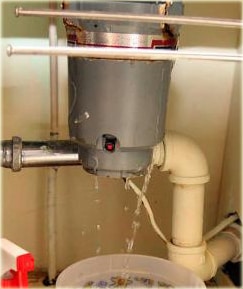Practical Methods for Fixing a Dripping Garbage Disposal
Practical Methods for Fixing a Dripping Garbage Disposal
Blog Article
We've noticed the article relating to Garbage Disposal Leaking From Bottom down the page on the net and accepted it made perfect sense to relate it with you in this article.

Garbage disposals are vital cooking area devices that aid in dealing with food waste efficiently. However, a dripping garbage disposal can be a frustrating and untidy issue to take care of. The good news is, numerous leaks can be fixed quickly with a couple of basic steps. In this write-up, we will go over how to repair a dripping waste disposal unit efficiently.
Intro
Waste disposal unit are mounted under kitchen sinks and are made to shred food waste into smaller pieces, permitting it to travel through the plumbing system quickly. While these tools are usually reputable, leakages can happen with time as a result of damage, loosened links, or damage to the unit.
Step-by-Step Guide to Fixing a Dripping Waste Disposal Unit
Shut off the Power
Prior to trying any type of repairs, guarantee that the power to the garbage disposal unit is turned off to stop the threat of electrical shock.
Situate the Leak
Determine the exact area of the leakage and identify the reason
Tighten up Connections
Use a wrench to tighten any type of loosened links between the disposal device and the pipes system.
Change Seals or Gaskets
If the leakage is because of used seals or gaskets, eliminate the old parts and replace them with new ones.
Patching Splits or Holes
For cracks or holes in the disposal unit, use epoxy or an ideal patching material to seal the damaged area.
Identifying the Source of the Leakage
Prior to trying to take care of a leaking garbage disposal, it is vital to identify the source of the leakage. This can typically be done through visual evaluation or by conducting easy tests.
Visual Evaluation
Examine the garbage disposal system meticulously for any kind of indicators of water leak. Pay very close attention to areas around seals, gaskets, and connection factors.
Testing for Leakages
One method to evaluate for leakages is by running water via the disposal system and looking for any type of visible indications of leak.
Usual Root Causes Of Leakages in Waste Disposals
Worn Seals and Gaskets
Seals and gaskets play a crucial role in avoiding water from dripping out of the waste disposal unit. In time, these parts can deteriorate, resulting in leakages around the disposal unit.
Loose Connections
The connections between the garbage disposal and the pipes system can come to be loosened in time, causing water to leakage out throughout operation.
Splits or Holes in the Disposal Unit
Physical damages to the waste disposal unit, such as cracks or holes in the housing, can also lead to leakages.
Tools and Products Needed for Dealing With a Leaking Waste Disposal Unit
Before starting the repair service procedure, gather the required devices and materials, including a screwdriver, flexible wrench, plumbing's putty, substitute seals or gaskets, and epoxy or patching product for fixing splits or openings.
Testing the Garbage Disposal After Repair Work
As soon as the repair is full, check the waste disposal unit by running water via it to make sure that the leakage has been fixed.
Preventive Upkeep Tips to Stay Clear Of Future Leaks
To stop future leaks, it is essential to do normal maintenance on your waste disposal unit. This consists of maintaining it tidy, preventing placing non-food products or difficult things down the disposal, and occasionally checking for leakages or various other problems.
Conclusion
To conclude, taking care of a leaking garbage disposal is a relatively straightforward process that can be finished with standard tools and materials. By adhering to the steps outlined in this post and exercising preventative maintenance, you can maintain your waste disposal unit in good working condition and avoid pricey repair services in the future.
HERE’S HOW TO FIX YOUR GARBAGE DISPOSAL
WHAT TO DO IF SOMETHING IS STUCK IN YOUR GARBAGE DISPOSAL
If the impeller won’t turn, there’s probably something stuck in the disposal. It could be a steak bone or peach pit, although plumbers report pulling all sorts of inappropriate objects out of disposals, such as bottle caps or aluminum foil. Make sure power to the disposal is off, and look inside to see if you can see the source of the jam.
Never stick your fingers in a disposal. Pull out anything you see with tongs or pliers.
If the disposal still won’t work, it may be time to call a plumber or consider buying a new disposal. GEM Plumbing & Heating is here for all of your garbage disposal needs.
WHAT TO DO IF YOUR GARBAGE DISPOSAL DRAIN IS CLOGGED
Take everything out from underneath your sink and put a bucket or other container under your disposal to catch any water that drains out. Disconnect your disposal from the power supply. If it’s plugged into a wall outlet, unplug it. If it’s hardwired into an electrical box, go to the electrical panel and turn off the breaker for the disposal. Pour ¼ cup of baking soda into the drain, followed by ½ cup of white vinegar. Give the solution a few minutes to fizz and do its work. Look into the disposal with a flashlight to see if you can see an object that might be causing the clog. If you see it, remove it using tongs or pliers. MORE TIPS ON DEALING WITH A CLOGGED GARBAGE DISPOSAL
Never use drain cleaner in a garbage disposal. It can damage the plastic parts inside the disposal. You can also be splashed with the caustic liquid while working to clear the clog. Beware! Never stick your fingers into a garbage disposal. Trust us — not a good idea. In many instances, your dishwasher drains through your garbage disposal. This allows the disposal to grind any large food particles that may be drained out of your dishwasher. There are some jurisdictions, however, where the plumbing code prohibits such a connection. WHAT TO DO WHEN YOUR DISHWASHER DRAINS THROUGH THE DISPOSAL
Run some water in the sink so your plunger has at least a ½-inch of water to create a seal and plunge vigorously up and down several times. You may need to repeat this several times. Run hot water down the drain to clear any residue that remains.

We were shown that editorial about Why Is from an associate on our other site. If you liked our article please remember to pass it around. I treasure reading our article about Why Is .
Call Report this page